|
|
|
Sort Order |
|
|
|
Items / Page
|
|
|
|
|
|
|
| Srl | Item |
| 1 |
ID:
159910
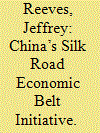

|
|
|
|
|
| Summary/Abstract |
This article demonstrates that, rather than constituting a new model for Central Asian international relations, the SREB’s real strategic value for China is as an organizational concept and as an influence multiplier. In recasting its Central Asian bilateral relations as part of the SREB engagement model, Beijing has overlaid a strategic-level concept to its otherwise disparate patterns of engagement. In so doing, the Xi administration has consolidated its multiple lines of efforts and the diverse Chinese-based actors—both state and private—into a grand narrative: one that serves the strategic purpose of integration. The Xi administration has used (and is using) this integration to expand its influence throughout the Central Asian region, both through its bilateral relations and through a SREB-resulting network of Central Asian states. In particular, one sees regular instances within China’s SREB engagement where the Xi administration uses the initiative to reconstitute regional states’ development priorities, interests and relations in ways that benefit China’s overall strategic interests.
|
|
|
|
|
|
|
|
|
|
|
|
|
|
|
|
| 2 |
ID:
159911
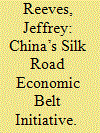

|
|
|
|
|
| Summary/Abstract |
This article demonstrates that, rather than constituting a new model for Central Asian international relations, the SREB’s real strategic value for China is as an organizational concept and as an influence multiplier. In recasting its Central Asian bilateral relations as part of the SREB engagement model, Beijing has overlaid a strategic-level concept to its otherwise disparate patterns of engagement. In so doing, the Xi administration has consolidated its multiple lines of efforts and the diverse Chinese-based actors—both state and private—into a grand narrative: one that serves the strategic purpose of integration. The Xi administration has used (and is using) this integration to expand its influence throughout the Central Asian region, both through its bilateral relations and through a SREB-resulting network of Central Asian states. In particular, one sees regular instances within China’s SREB engagement where the Xi administration uses the initiative to reconstitute regional states’ development priorities, interests and relations in ways that benefit China’s overall strategic interests.
|
|
|
|
|
|
|
|
|
|
|
|
|
|
|
|
| 3 |
ID:
159912
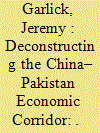

|
|
|
|
|
| Summary/Abstract |
Intense interest in the China–Pakistan Economic Corridor (CPEC) was stimulated when US$46 billion of investment agreements were signed in April 2015, a sum which two years later increased to US$62 billion. A major focus of CPEC is on developing overland transportation and pipeline links from the port of Gwadar to the Chinese province of Xinjiang as a land-based alternative to the maritime ‘chokepoint’ of the Straits of Malacca. This article assesses the viability of pipelines connecting China to the Indian Ocean through Pakistan via a close analysis of evidence obtained from both primary and secondary sources. It concludes that the overland connection is beset with difficulties because of geographical, economic and security problems, and that China’s long-term motivations for maintaining a presence in Pakistan are likely to be chiefly geopolitical rather than geo-economic. In fact, China’s primary aim with CPEC and other investments is to hedge against India by establishing a physical presence in the Indian Ocean Region (IOR), a strategy which is herein referred to as geo-positional balancing.
|
|
|
|
|
|
|
|
|
|
|
|
|
|
|
|
| 4 |
ID:
159918


|
|
|
|
|
| Summary/Abstract |
Through the lens of securitization theory, this article looks at the significant impact that non-traditional security has had over Chinese foreign policy. Over time, non-traditional security has changed from being understood as an opportunity to boost China’s international standing, to being seen as an important category within security threats. China’s security and diplomatic behavior has changed accordingly. In particular, China has become more confident in using and authorizing force. This article pinpoints this process started in the 1990s by looking at the debate within the government and the legal, institutional and military response against those new threats. It also prompts important considerations about the drivers and the direction of Chinese foreign policy, and the general approach of studying the same subject.
|
|
|
|
|
|
|
|
|
|
|
|
|
|
|
|
| 5 |
ID:
159913


|
|
|
|
|
| Summary/Abstract |
What does human rights mean to the Chinese government in the post-Tiananmen era? Has the way by which Beijing conceptualizes human rights changed over time? What policies and practices have Beijing’s human rights conception privileged or delegitimized? The article takes on these intriguing questions by analyzing human rights stories in the People’s Daily. The research applies the methods of text analytics and discourse analysis to shed light on the Party-state’s effort of incorporating and reformulating the idea of human rights. It is found that, since 1989, the Chinese government has developed two major conceptions of human rights. Throughout the 1990s, human rights had been understood mainly as a source of regime threat and insecurity, hence requiring containment and rejection. Beginning in the early 2000s, an alternative argument was constructed that conceptualizes human rights as the governing capacity of the Party-state, hence deserving reception and acclamation. The rights-as-capacity argument has developed side-by-side with the rights-as-threat conception, resulting in an illiberal and dualistic rights regime in Chinese politics.
|
|
|
|
|
|
|
|
|
|
|
|
|
|
|
|
| 6 |
ID:
159919


|
|
|
|
|
| Summary/Abstract |
China has recently become one of the world’s largest shale gas producers. However, little is known about how shale gas development and fracking affect local communities in China nor how local communities view this development. Drawing on fieldwork conducted during August 2015 in two villages in Sichuan province and Chongqing municipality, this article shows that while fracking leads to serious environmental and social problems there are also substantial economic and social benefits. Furthermore, this study uncovers both active and resigned support of shale gas development in rural China depending on whether local residents prioritize economics or politics.
|
|
|
|
|
|
|
|
|
|
|
|
|
|
|
|
| 7 |
ID:
159914
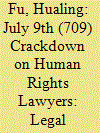

|
|
|
|
|
| Summary/Abstract |
This article first studies the 2015 crackdown on human rights lawyers in China and the context in which the crackdown took place. It then analyses the development of three types of human rights lawyers since 2011—the weiquan (rights protection) lawyers, the sike (die-hard) lawyers and the gongyi (public interest) lawyers—the interaction among them and the challenge they pose to the authoritarian governance. Finally, the article proposes three likely scenarios for human rights lawyering in China.
|
|
|
|
|
|
|
|
|
|
|
|
|
|
|
|
| 8 |
ID:
159916


|
|
|
|
|
| Summary/Abstract |
Chengzhongcun, or ‘villages-in-the-city’, have been a major feature of China’s urban landscape in the post-Mao era. The existing literature largely casts them as side effects of rapid urbanization or a momentary oddity of market transition providing temporary solutions to urban needs until more efficient mechanisms for affordable housing and social welfare are developed. This article positions chengzhongcun within the broader system of unequal exchange that is at the heart of China’s rural–urban dual system and development model. This article argues that chengzhongcun are an inherent feature of China’s post-Mao urbanization model, a physical manifestation of its dual system that differentially regulates people and space according to their classifications as ‘rural’ or ‘urban’. China’s urban development must be understood as a product of this dual system based on the exploitation of the rural sector, including its land, property and people.
|
|
|
|
|
|
|
|
|
|
|
|
|
|
|
|
| 9 |
ID:
159917
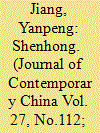

|
|
|
|
|
| Summary/Abstract |
Shanghai, like other large Chinese cities, has multiple business districts. This paper examines the construction of one of its largest, at Hongqiao in the west of the city. Its specific focus lies in the central role played by one state-owned company, Shenhong, in the financing and construction first of the Hongqiao transport hub and then of the business district that jointly make up this new development pole. The paper examines in detail Shenhong as an organization as well as the tasks it has undertaken and the funding difficulties it has confronted. It argues that Shenhong is representative of the seldom discussed state-owned urban investment and development companies that have led the urbanization of China. Finally, it anchors these companies into theoretical debates, arguing that their ubiquitous involvement in China’s property-led process of urban transformation combined with their ambivalence as state companies operating along similar lines to private enterprises means that they can be seen as central players in a form of state corporatist urbanism.
|
|
|
|
|
|
|
|
|
|
|
|
|
|
|
|
| 10 |
ID:
159915


|
|
|
|
|
| Summary/Abstract |
The Chinese Communist Party’s (CCP) ‘with-Chinese-characteristics’ discourse proclaims its superiority in reflecting people’s genuine needs without poisonous partisan politics, as in Western democracies. The Party’s consultative democracy, as represented by its allies in forums including the Chinese People’s Political Consultative Conference, is key to this superiority. Consequently, the organizer of these inputs, the United Front Work Department (UFWD), is a key element of CCP legitimacy as its organizer of representation of the increasing number of non-Party social forces. This ostensible alliance allows the Party to proclaim itself as the representative of the overwhelming majority of the Chinese people. Nevertheless, little recent work has been done on either this consultation or the Department. Through the processes of legitimation and de-legitimation, this article decodes how this consultative process works by examining the UFWD’s methods in relation to religious believers. Under Xi Jinping, united front work is again being prioritized and is closely tied to his reform plans.
|
|
|
|
|
|
|
|
|
|
|
|
|
|
|
|
|
|
|
|
|